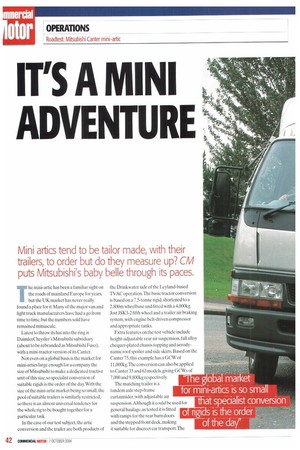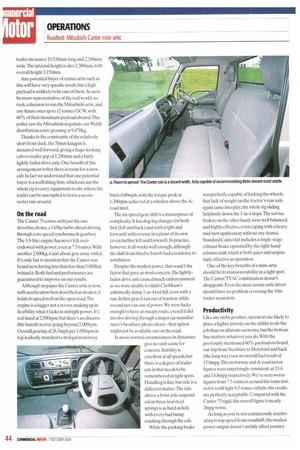IT'S A MINI ADVENTURE
Page 42

Page 44

Page 45

If you've noticed an error in this article please click here to report it so we can fix it.
Mini artics tend to be tailor made, with their
trailers, to order but do they measure up? CM
puts Mitsubishi's baby belle through its paces.
The mini-artic has been a familiar sight on the roads of mainland Europe for years, but the UK market has never really found a place for it. Many of the major van and light truck manufacturers have had a go from time to time, but the numbers sold have remained minuscule.
Latest to throw its hat into the ring is DaimlerChrysler's Mitsubishi subsidiary (about to be rebranded as Mitsubishi Fuso), with a mini-tractor version of its Canter.
Not even on a global basis is the market for mini-artics large enough for a company the size of Mitsubishi to make a dedicated tractive unit of this size, so specialist conversion of suitable rigids is the order of the day.With the size of the mini-artic market being so small, the pool of suitable trailers is similarly restricted, so there is an almost universal tendency for the whole rig lobe bought together for a particular task.
In the case of our test subject, the artic conversion and the trailer are both products of the Drinkwater side of the Leyland-based TVAC operation.The basic tractor conversion is based on a 7.5-tonne rigid,shortened to a 2.800m wheelbase and fitted with a 4,000kg Jost JSK3-2 fifth wheel and a trailer air braking system, with engine belt-driven compressor and appropriate tanks.
The matching trailer is a tandem axle step-frame curtainsider, with adjustable air suspension. Although it could be used for general haulage, as tested it is fitted with ramps for the rear barn doors and the stepped front deck, making it suitable for discreet car transport.The trailer measures 10,530mm long and 2,300nun wide.The internal height is also 2,300mm, with overall height 3,150trun.
Any potential buyer of a mini-artic such as this will have very specific needs, but a high payload is unlikely to be one of them. So as to be more representative of the real world, we took a decision to run the Mitsubishi artic, and any future ones up 10 12 tonnes GCW, with 60% of their maximum payload aboard This policy saw the Mitsubishi negotiate our Welsh distribution route grossing at 9,470kg.
Thanks to the constraints of the relatively short front deck. the 50mm kingpin is mounted well forward,giving a huge-looking cab-to-trailer gap of 1,200mm and a fairly lightly-laden drive axle. One benefit of this arrangement is that there is room for a crewcab. In fact we understand that one potential buyer is a scaffolding firm, which can use the whole rig to carry equipment to site, where the trailer can be uncoupled to leave a sevenseater run-around.
On the road
The Canter 75 comes with just the one driveline choice, a 143hp turbo-diesel driving through a six-speed synchromesh gearbox. The 3.9-litre engine has never felt overendowed with power, even at 7.5 tonnes. With another 2.000kg, it just about gets away with it. It's only fair to mention that the Canter was brand new,having less than less than 5,000km behind it. Both fuel and performance are guaranteed to improve on our results.
Although on paper the Canter artic is slow, with acceleration best described as modest, it holds its speed well on the open road.The engine is a lugger not a revver, making up in flexibility what it lacks in outright power. It's red-lined at 2,500rpm, but there's no discernible benefit in ever going beyond 2.000rpm. Overall gearing of 26.5mph per 1,000rpm in top is ideally matched to its legal motorway limit of 60mph. with the torque peak at 1,300rpm achieved at a whisker above the Aroad limit.
The six-speed gear shift is a masterpiece of complexity. It has dog-leg changes for both first (left and back) and sixth (right and forward) with reverse in a plane of its own (even further left and forward). In practice, however, it all works well enough, although the shift from third to fourth had a tendency to notchiness.
Despite the modest power, that wasn't the factor that gave us most concern. The lightlyladen drive axle caused much embarrassment as we were unable to climb Chobharn's admittedly damp 1-in-4 test hill, even with a run. In first gear it ran out of traction, while second just ran out of power. We were lucky enough to have an escape route, even if it did involve driving through a major car manufacturer's brochure photo-shoot — that option might not be available out on the road.
In more normal circumstances its dynamics give no such cause for concern. Stability is excellent at all speeds, but there is a degree of trailer cut-in that needs lobe remembered in tight spots. Handling is fine, but ride is a different matter. The ride above a front axle suspended on three-leaf steel springs is as hard as hell, with every bad bump crashing through the cab.
While the parking brake was perfectly capable of locking the wheels, that lack of weight on the tractor's rear axle again came into play. the whole rig sliding helplessly down the 1-in-4 slope.The service brakes, on the other hand, were well balanced and highly effective, even coping with a heavy mid-turn application without any drama. Standard Canter kit includes a single-stage exhaust brake operated by the right-hand column stalk which is both quiet and surprisingly effective in operation.
One of the key benefits of a mini-artic should be its manoeuvrability in a tight spot. The Canter/TVAC combination doesn't disappoint. Even the most novice artic driver should have no problem reversing the 10m trailer accurately.
Productivity
Like any niche product, operators are likely to place a higher priority on the ability to do the job than on ultimate economy, but the bottom line matters, whatever you do. With the previously mentioned 60% payload on board, our trip from Newbury to Hereford and back (the long way) saw an overall fuel result of 15.0mpg.The motorway and A-road sector figures were surprisingly consistent, at 15.4 and 14.8mpg respectively. We've seen worse figures from 7.5-tonners around the same test, so for a still tight 9.5-tonne vehicle,the results are perfectly acceptable. Compared with the Canter 75 rigid, the overall figure is nearly 2mpg worse.
As long as you're not continuously accelerating to top speed from standstill, the modest power output doesn't unduly affect journey times On the undulating run along the M4, we achieved an average speed of 87.6km/h, despite a limiter set at 90km/h. On A-roads, the gearing meant that we bowled along through the Herefordshire countryside without frustration. In fact its A-road time was slightly faster than the Canter 75 rigid.
Payload is not especially relevant on the mini-artic — if it was you wouldn't buy one, Weighing in at just over five and a half tonnes for the whole outfit, its gross payload of 5,400kg is nearer a 7,5-tonner than a 12-tonner. What's more impressive is the 56m3 volume.
The Canter has a basic 36 month/100,000km warranty. while TVAC's contribution is backed by 12 months/36.000km extendable cover. All Mitsubishi Canter dealers have access to the specialist back-up information for the conversion.
Cab comfort
Little has changed within the familiar Canter cab in the course of its conversion to a tractor. Only an extra switch panel for the suspension air gauge, raise/lower control and an assortment of warning lights suggests something is different.
The remainder of the dash features the instrument panel, comprising a traditional tachograph with revs, fuel and coolant, switches for front and rear foglights, engine oil check and heated mirrors, a headlamp leveller and a hand throttle. Entertainment is courtesy of a VDO radio cassette unit.
The mechanically-suspended driving seat and steering column are both fully adjustable, allowing most shapes to get surprisingly comfortable.
Unlike most of its Far East-derived competitors, the Canter cab is a decent width, fully capable of accommodating three grown-up occupants. The dual passenger seat has the usual fold down centre backrest which serves as both table top and document storage.
The parking brake is a cable-operated affair, controlled by an uninspiring umbrella lever under the dash, but at least it's out of the way. This,together with the flat floor,makes it easy to slide across to the passenger door if necessary.
Regular and wide-angle mirrors on both sides give good rearwards visibility, while an excellent view forwards has always been a Canter feature.The only omission is a nearside kerb mirror, but the Canter's almost car-like driving position allows a good awareness of what's happening around the cab. •






























































































































































































